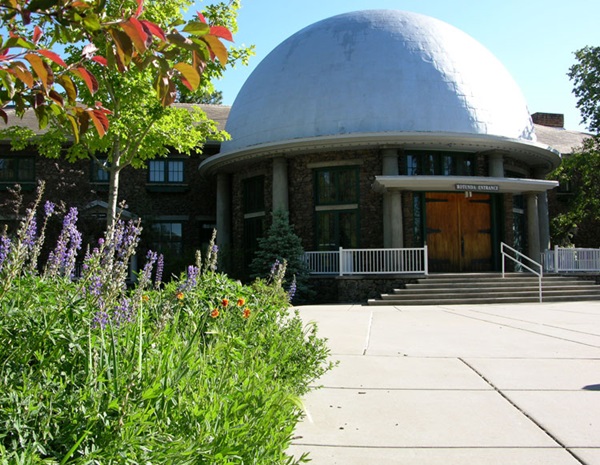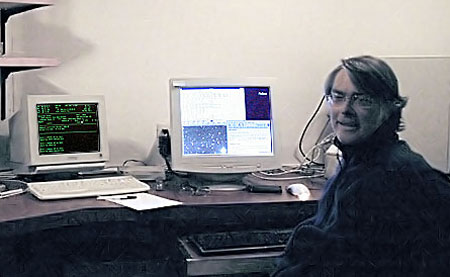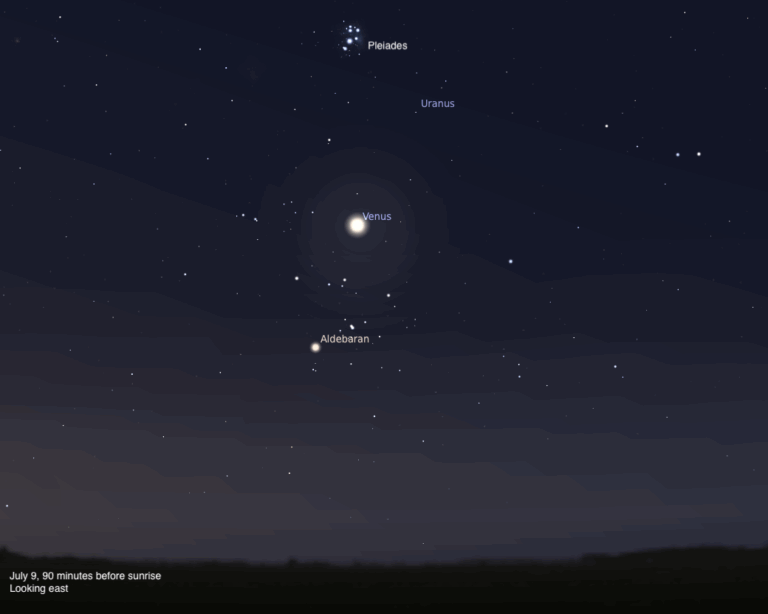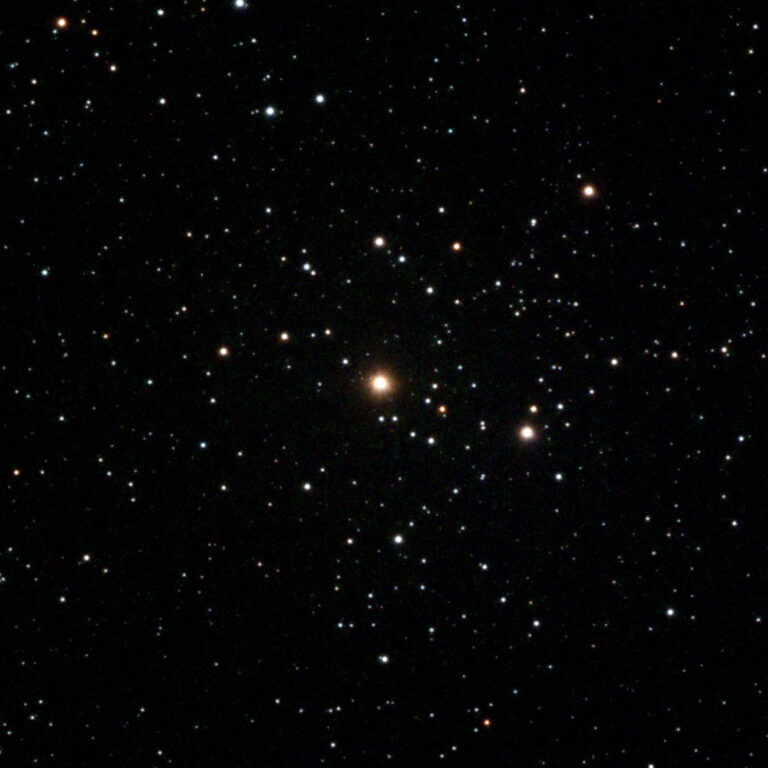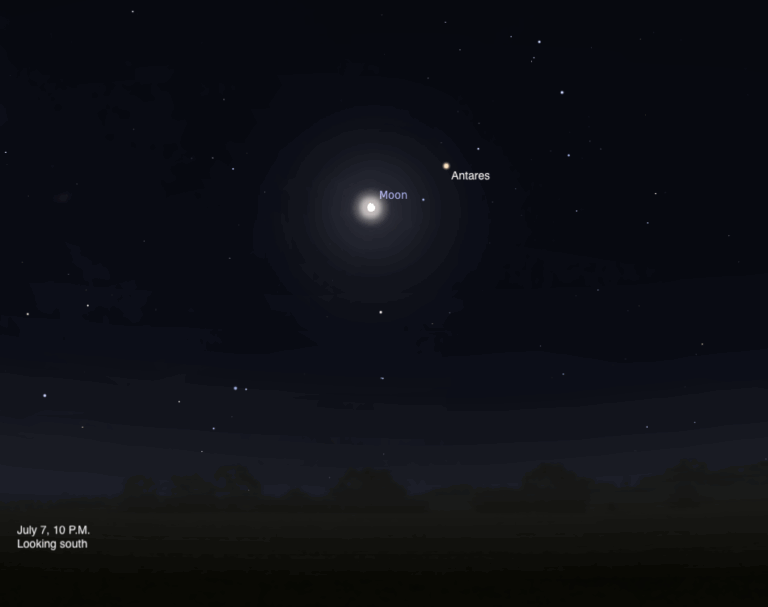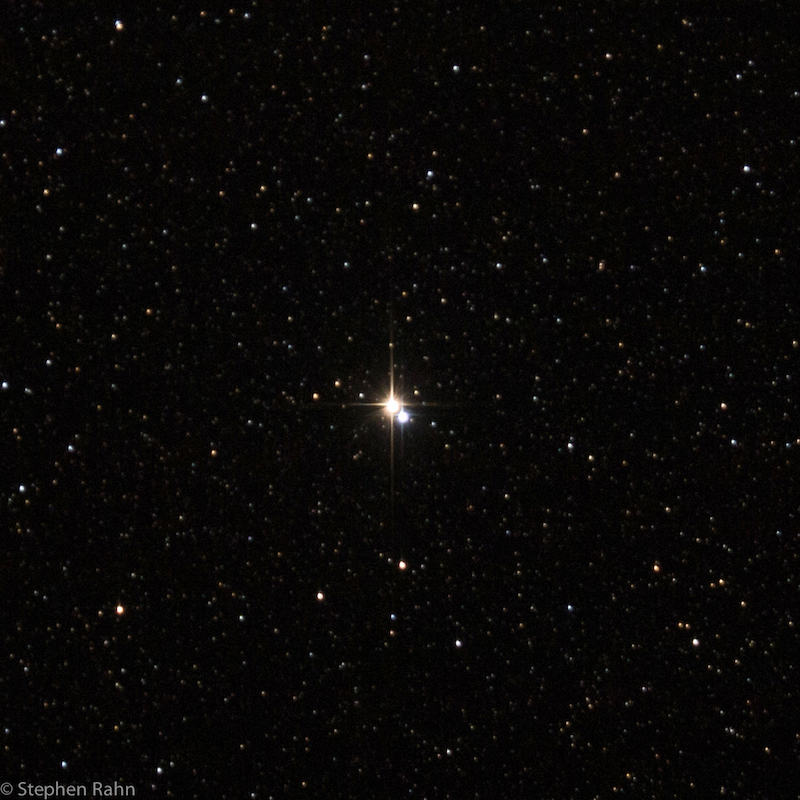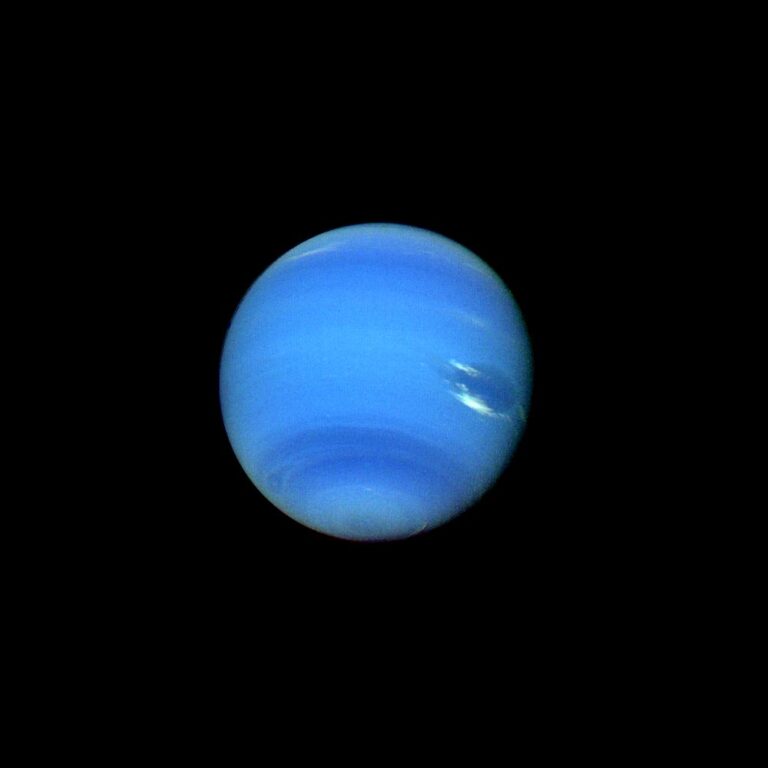Key Takeaways:
Brian Skiff: On any clear night, I can be found at one of three research telescopes — 72-inch, 42-inch, or 22-inch LONEOS Schmidt camera — at our Anderson Mesa dark-sky site, east-southeast of Flagstaff. Typically, I do imaging and polarimetry of star clusters and active galaxies, take spectra of Sun-like stars, or hunt for asteroids. Although it is only part of my job, the asteroid stuff gets published rapidly, and so it has the potential to generate timely news. This doesn’t mean it’s more important; it’s just how the work gets out.
B.S.: The Lowell Observatory Near-Earth Object Search (LONEOS) is specifically helping to inventory the larger asteroids that belong to the near-Earth population and that can potentially threaten Earth. Occasional discoveries of comets come along as a normal part of this surveying. This project is just one of several NASA-funded projects doing similar work. You can find some information about this type of observing at the Minor Planet Center web site.
Amateur astronomers also do a significant amount of follow-up of new discoveries to measure asteroid positions on the sky so their orbits can be tracked. Their work has been indispensable.
B.S.: For the asteroid survey, we use a refurbished 22-inch (0.6-meter) Schmidt telescope with a corrector plate of about 22-inches aperture and operating at f/1.8. The CCD camera covers about 8 square degrees of sky (about 2.8° by 2.8°). In our usual unfiltered 45-second exposures, we reach about magnitude 19.5.
B.S.: The LONEOS project commenced observing in 1998. Any survey like this must be computerized, if only because a computer controls the CCD camera. In fact, projects similar to LONEOS have several computers running various parts of the system. In our case, one machine runs the telescope itself, controlling where the scope points. A second commands the camera to open or close the shutter, read-out the data, etc. Finally, a pair of computers, each with multiple processors, analyzes the data to find particular objects, measure coordinates, and display the targets it finds.
B.S.: Because our eyes seem to be good at finding moving things against a background field (asteroids on a star field or “dinner” trotting across the savannah), they are effective at picking out targets like asteroids on photographic plates or CCD images. However, this is perhaps the only advantage. You get bored or simply tired or distracted doing it for too long. So, you miss stuff.
Unfortunately, software still doesn’t catch everything. And, of course, the sheer volume of data we produce even with our little telescope — around 10 gigabytes per night — would be overwhelming for many sets of human eyes to examine the way Tombaugh did.
B.S.: When the proper-motion survey was started, using Tombaugh’s (and others’) plates as the first epoch, a new blink machine was built that used a projection apparatus rather than an eyepiece. The photo one commonly sees of Tombaugh with the blink comparator shows him looking through an eyepiece.
This system was re-arranged optically so the images were projected onto a small white plate perhaps 3″ or 4″ square. The plate was mounted on a rotating base including a micrometer movement, so small motions and angles could be measured. Eventually, there were encoders attached to the micrometer wheel, so the numbers could be recorded on a computer (a teletype terminal, now an item worthy of a computer museum!). This was the rig we used until the late 1980s to blink plates taken for the asteroid survey with the Pluto Camera.
B.S.: Just considering the LONEOS data since 1998, we have about 7,000 numbered asteroids credited to the project and about two dozen comets. There are a lot more asteroids that haven’t been observed well enough to be numbered yet, so this figure is bound to grow.
B.S.: All the LONEOS asteroid discoveries are assigned simply to the project, rather than the observers, because there’s more to the project than just observing, such as software creation and data analysis. From earlier work at Lowell, when the finds were assigned individually, I have about 50 asteroids to my credit, all ordinary main-belt asteroids. One is named for Astronomy editor Dave Eicher.
I have nine comets with my name attached (as of December 2005). This number grows about one per year.
B.S.: This near-Earth asteroid was observed for only a week in 1937, and the positional measurements observers made then were sometimes poor. After the object’s appearance, astronomers were not certain which of the observations were reliable, and which were not. Thus, Hermes was lost, and the uncertainty in its sky location 70 years downstream was effectively a narrow band spanning the entire sky. We knew it had to be a close-Earth approacher because its motion across the sky in 1937 was so fast.
I picked up the asteroid just as I would any other object. We take four exposures spaced by about 20 or 30 minutes apart of a patch of sky. The computer software analyzes the images to detect anything with a significant signal above some background threshold — which includes stars, galaxies, chip flaws, cosmic ray strikes, and so on. This scanning process also measures coordinates for everything the computer finds.
In general, we do not examine such detections individually, and perhaps 1 or 2 percent of these are false detections. We send the position measurements of main-belt asteroids to the Minor Planet Center (MPC). They add this information to an archive to compare with earlier and later observations by others and us.
About one in 1,000 real objects are near-Earth asteroids. Either their Vaisala orbit calculation shows they could have near-Earth orbits or they are moving much faster than main-belt asteroids as a result of being close to Earth. A human observer then examines these finds. Nowadays, most of the fast-moving asteroids we can detect with our relatively small telescope are known, so we have a low discovery rate. However, we still find a few new ones each month.
The object that turned out to be Hermes was distinctive, mainly because it was so bright. After we located it (the software, not the observer, really makes the discoveries), I checked a query page on the MPC’s web site that lists known objects within a small radius of a specified position. This search turned up empty. There also were no objects near it on the MPC’s “NEO Confirmation Page” that lists the latest discoveries not yet officially announced.
No asteroid as bright (magnitude 14) had been discovered in the couple of years prior, which was remarkable. Its motion was that of an Apollo asteroid — one that crosses Earth’s orbit — so I sent a report to the MPC with the data. Within a few hours, the MPC obtained additional data, both from observations and archived positions, and, thus, the identification with Hermes was made.
Some additional details about the discovery and identification are given in “Tumbling Stone”, a web publication of the Spaceguard Foundation in Italy. It includes a short animation of the discovery images. In addition, there is an article about the discovery in our house newsletter. This includes details about radar observations showing Hermes is a binary asteroid. Hermes’ orbit was quickly improved so it could be numbered (69230). In autumn 2005, I picked up Hermes again with the LONEOS telescope — but, of course, now it is just another well-studied Apollo asteroid!
B.S.: I’m still not convinced anything in astronomy has much practical application! Indeed, until recently, we have used the data solely to find asteroids. But, obviously, there’s a lot more on the images: variable stars, supernovae by the thousands, galaxies, even man-made satellites and space junk. We are just beginning to explore how to extract additional results from the several terabytes of data we have accumulated over the years.
B.S.: Historically, there have been lots of us observing-assistant types behind the scenes in astronomy — whether it was the guys running the Harvard sky-patrol cameras for decades, pushing telescopes around making photoelectric observations of stars or taking spectra, or, more recently, babysitting nearly automated telescopes. They do good work, and then disappear.
A lot of people (including “real” astronomers) would tell you this is closer to the true vocation of astronomy than what the bosses do. Tombaugh is part of that lineage: He knew how to get the most out of a particular instrument and dug out what results he could with the resources he had (both hardware, and mentally). Certainly finding what we would now call the first Kuiper Belt object is a considerable achievement — Pluto might not have been found until the 1950s if he hadn’t undertaken the survey for it.
A larger legacy that Tombaugh and his Lowell contemporaries who used the “Pluto Camera” left us is the complete photographic coverage of the northern sky down to about magnitude 17 or 18. This survey is the oldest deep, homogeneous sky survey. These plates provided the first-epoch plates for the Lowell proper-motion program, accomplished in the 1960s when astronomers exposed new plates on the same centers to look for nearby stars using the manual blink method. (Nearly all the plates and the blinking was done by Bob Burnham of Celestial Handbook fame, and Norm Thomas — two more people hunkered down in the trenches of astronomy.)
In terms of later astronomical results relying on it, the proper-motion project was the most important result to come from the Pluto Camera. Because of their early vintage, those old plates continue to hold useful information, which newer technology may yet be able to extract.
Brian Skiff: On any clear night, I can be found at one of three research telescopes — 72-inch, 42-inch, or 22-inch LONEOS Schmidt camera — at our Anderson Mesa dark-sky site, east-southeast of Flagstaff. Typically, I do imaging and polarimetry of star clusters and active galaxies, take spectra of Sun-like stars, or hunt for asteroids. Although it is only part of my job, the asteroid stuff gets published rapidly, and so it has the potential to generate timely news. This doesn’t mean it’s more important; it’s just how the work gets out.
B.S.: The Lowell Observatory Near-Earth Object Search (LONEOS) is specifically helping to inventory the larger asteroids that belong to the near-Earth population and that can potentially threaten Earth. Occasional discoveries of comets come along as a normal part of this surveying. This project is just one of several NASA-funded projects doing similar work. You can find some information about this type of observing at the Minor Planet Center web site.
Amateur astronomers also do a significant amount of follow-up of new discoveries to measure asteroid positions on the sky so their orbits can be tracked. Their work has been indispensable.
B.S.: For the asteroid survey, we use a refurbished 22-inch (0.6-meter) Schmidt telescope with a corrector plate of about 22-inches aperture and operating at f/1.8. The CCD camera covers about 8 square degrees of sky (about 2.8° by 2.8°). In our usual unfiltered 45-second exposures, we reach about magnitude 19.5.
B.S.: The LONEOS project commenced observing in 1998. Any survey like this must be computerized, if only because a computer controls the CCD camera. In fact, projects similar to LONEOS have several computers running various parts of the system. In our case, one machine runs the telescope itself, controlling where the scope points. A second commands the camera to open or close the shutter, read-out the data, etc. Finally, a pair of computers, each with multiple processors, analyzes the data to find particular objects, measure coordinates, and display the targets it finds.
B.S.: Because our eyes seem to be good at finding moving things against a background field (asteroids on a star field or “dinner” trotting across the savannah), they are effective at picking out targets like asteroids on photographic plates or CCD images. However, this is perhaps the only advantage. You get bored or simply tired or distracted doing it for too long. So, you miss stuff.
Unfortunately, software still doesn’t catch everything. And, of course, the sheer volume of data we produce even with our little telescope — around 10 gigabytes per night — would be overwhelming for many sets of human eyes to examine the way Tombaugh did.
B.S.: When the proper-motion survey was started, using Tombaugh’s (and others’) plates as the first epoch, a new blink machine was built that used a projection apparatus rather than an eyepiece. The photo one commonly sees of Tombaugh with the blink comparator shows him looking through an eyepiece.
This system was re-arranged optically so the images were projected onto a small white plate perhaps 3″ or 4″ square. The plate was mounted on a rotating base including a micrometer movement, so small motions and angles could be measured. Eventually, there were encoders attached to the micrometer wheel, so the numbers could be recorded on a computer (a teletype terminal, now an item worthy of a computer museum!). This was the rig we used until the late 1980s to blink plates taken for the asteroid survey with the Pluto Camera.
B.S.: Just considering the LONEOS data since 1998, we have about 7,000 numbered asteroids credited to the project and about two dozen comets. There are a lot more asteroids that haven’t been observed well enough to be numbered yet, so this figure is bound to grow.
B.S.: All the LONEOS asteroid discoveries are assigned simply to the project, rather than the observers, because there’s more to the project than just observing, such as software creation and data analysis. From earlier work at Lowell, when the finds were assigned individually, I have about 50 asteroids to my credit, all ordinary main-belt asteroids. One is named for Astronomy editor Dave Eicher.
I have nine comets with my name attached (as of December 2005). This number grows about one per year.
B.S.: This near-Earth asteroid was observed for only a week in 1937, and the positional measurements observers made then were sometimes poor. After the object’s appearance, astronomers were not certain which of the observations were reliable, and which were not. Thus, Hermes was lost, and the uncertainty in its sky location 70 years downstream was effectively a narrow band spanning the entire sky. We knew it had to be a close-Earth approacher because its motion across the sky in 1937 was so fast.
I picked up the asteroid just as I would any other object. We take four exposures spaced by about 20 or 30 minutes apart of a patch of sky. The computer software analyzes the images to detect anything with a significant signal above some background threshold — which includes stars, galaxies, chip flaws, cosmic ray strikes, and so on. This scanning process also measures coordinates for everything the computer finds.
In general, we do not examine such detections individually, and perhaps 1 or 2 percent of these are false detections. We send the position measurements of main-belt asteroids to the Minor Planet Center (MPC). They add this information to an archive to compare with earlier and later observations by others and us.
About one in 1,000 real objects are near-Earth asteroids. Either their Vaisala orbit calculation shows they could have near-Earth orbits or they are moving much faster than main-belt asteroids as a result of being close to Earth. A human observer then examines these finds. Nowadays, most of the fast-moving asteroids we can detect with our relatively small telescope are known, so we have a low discovery rate. However, we still find a few new ones each month.
The object that turned out to be Hermes was distinctive, mainly because it was so bright. After we located it (the software, not the observer, really makes the discoveries), I checked a query page on the MPC’s web site that lists known objects within a small radius of a specified position. This search turned up empty. There also were no objects near it on the MPC’s “NEO Confirmation Page” that lists the latest discoveries not yet officially announced.
No asteroid as bright (magnitude 14) had been discovered in the couple of years prior, which was remarkable. Its motion was that of an Apollo asteroid — one that crosses Earth’s orbit — so I sent a report to the MPC with the data. Within a few hours, the MPC obtained additional data, both from observations and archived positions, and, thus, the identification with Hermes was made.
Some additional details about the discovery and identification are given in “Tumbling Stone”, a web publication of the Spaceguard Foundation in Italy. It includes a short animation of the discovery images. In addition, there is an article about the discovery in our house newsletter. This includes details about radar observations showing Hermes is a binary asteroid. Hermes’ orbit was quickly improved so it could be numbered (69230). In autumn 2005, I picked up Hermes again with the LONEOS telescope — but, of course, now it is just another well-studied Apollo asteroid!
B.S.: I’m still not convinced anything in astronomy has much practical application! Indeed, until recently, we have used the data solely to find asteroids. But, obviously, there’s a lot more on the images: variable stars, supernovae by the thousands, galaxies, even man-made satellites and space junk. We are just beginning to explore how to extract additional results from the several terabytes of data we have accumulated over the years.
B.S.: Historically, there have been lots of us observing-assistant types behind the scenes in astronomy — whether it was the guys running the Harvard sky-patrol cameras for decades, pushing telescopes around making photoelectric observations of stars or taking spectra, or, more recently, babysitting nearly automated telescopes. They do good work, and then disappear.
A lot of people (including “real” astronomers) would tell you this is closer to the true vocation of astronomy than what the bosses do. Tombaugh is part of that lineage: He knew how to get the most out of a particular instrument and dug out what results he could with the resources he had (both hardware, and mentally). Certainly finding what we would now call the first Kuiper Belt object is a considerable achievement — Pluto might not have been found until the 1950s if he hadn’t undertaken the survey for it.
A larger legacy that Tombaugh and his Lowell contemporaries who used the “Pluto Camera” left us is the complete photographic coverage of the northern sky down to about magnitude 17 or 18. This survey is the oldest deep, homogeneous sky survey. These plates provided the first-epoch plates for the Lowell proper-motion program, accomplished in the 1960s when astronomers exposed new plates on the same centers to look for nearby stars using the manual blink method. (Nearly all the plates and the blinking was done by Bob Burnham of Celestial Handbook fame, and Norm Thomas — two more people hunkered down in the trenches of astronomy.)
In terms of later astronomical results relying on it, the proper-motion project was the most important result to come from the Pluto Camera. Because of their early vintage, those old plates continue to hold useful information, which newer technology may yet be able to extract.

